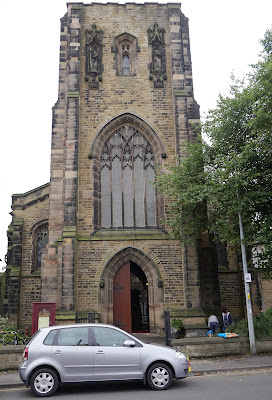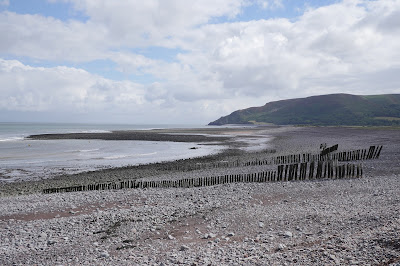Looking towards Tyneham Cap
Out friends John and Anne were visiting and wanted to see something of the South West Coast Path. We took them to what is arguably one of the very best sections on its entire 630 mile length. We parked at the car park at Kimmeridge and headed west towards Tyneham Cap. Moments after I too this picture a shepherd on a quad bike roared up and very quickly rounded up the sheep. It was a wonderful sight. (Interestingly, a shepherd's cottage is marked on the map, but I rather doubt that it was where this modern shepherd came from.)
We headed round to Hobarrow Bay, with rocky cliffs ahead.
We climbed up to the cliff top and had a great view back over Kimmeridge Bay and as far as St Aldhem's Head.
Soon the path began the long descent towards Warbarrow Bay. The low point is Arish Mell.
As we descended the curious outcrop of Warbarrow Tout became visible at the east end of the bay. Inland is the village of Tyneham, occupied by the Army during the Second World War and still part of the extensive MOD ranges.
And soon after that there was a more close up view of the lovely bay with its ring of chalk cliffs.
After coming down to sea level, the next task was to climb up to Flowers Barrow, an Iron Age hill fort. It covers about fifteen acres today, but at least a third of the original hill fort has been eroded and has tumbled into the sea. It is 160m above sea level.
As we began our descent from Flowers Barrow Lulworth Castle could be seen inland. It is a 17th century construction set in a large park. We have for some reason never explored it.
Now began the steep descent to Arish Moll - sharply followed by steep climb to Bill Hill.
This is the view back from the top of Bindon Hill. We last walked this part of the coast in August 2011 and at that point you could walk along the narrow path right at the top of the hill - now, because of erosion, the safe path is some way below the top, depriving you of the fine views previously available.
We passed Mupe Rocks, far below, and headed along the high path towards Lulworth.
The drawback of of this is we were almost deprived of a view of the wonderful cove, but I manged to remember the right path to make a short detour along.
At the end of the hill top I planned to descend Bindon Hill in the hope of seeing a few butterflies. This was partially successful in that we managed a few Chalkhill Blues and a lone Marbled White, but a path diversion took us a long way inland.
Conditions: warm and sunny.
Distance: about 8 miles.
Map: Explorer OL15 (Purbeck and South Dorset).
Rating: five stars.

















































